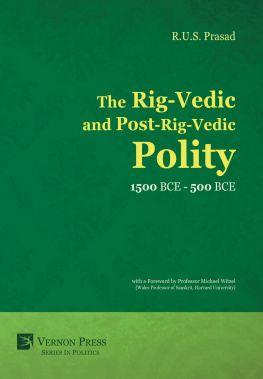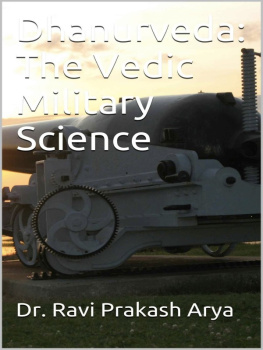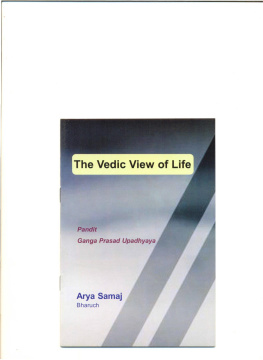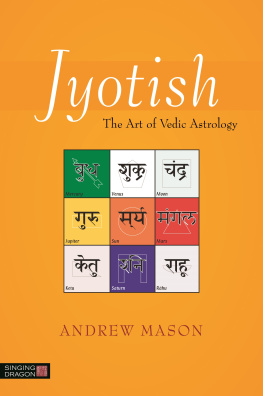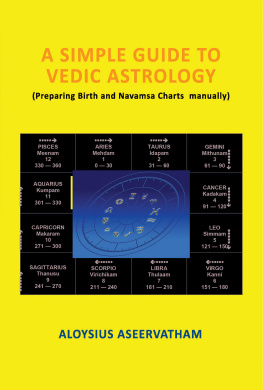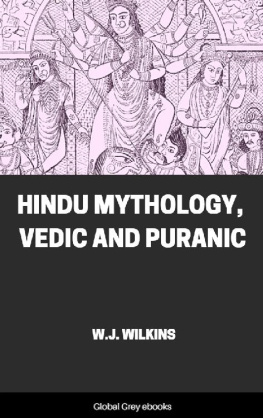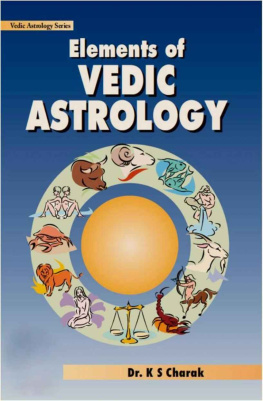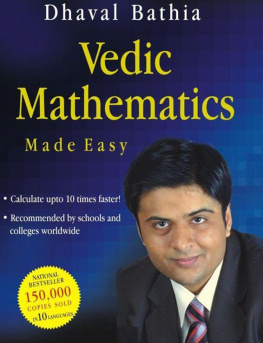THE
RIG-VEDIC
AND
POST-RIG-VEDIC
POLITY
(1500 BCE - 500 BCE)
R.U. S. PRASAD, Ph.D

Dedicated to my son Shantanu
For his human qualities
Copyright 2015 Vernon Press, an imprint of Vernon Art and Science Inc, on behalf of the author.
All rights reserved. No part of this publication may be reproduced, stored in a retrieval system, or transmitted in any form or by any means, electronic, mechanical, photocopying, recording, or otherwise, without the prior permission of Vernon Art and Science Inc.
www.vernonpress.com
In the Americas: Vernon Press 1000 N West Street, Suite 1200, Wilmington, Delaware 19801 United States | In the rest of the world Vernon Press C/Sancti Espiritu 17, Malaga, 29006 Spain |
Library of Congress Control Number: 2015934785
ISBN 978-1-62273-043-8
Product and company names mentioned in this work are the trademarks of their respective owners. While every care has been taken in preparing this work, neither the author nor Vernon Art and Science Inc. may be held responsible for any loss or damage caused or alleged to be caused directly or indirectly by the information contained in it.
Table of Contents
Composition of the Rgveda
and other Vedic texts - Possible locations
Chapter IX Political System and Institutions
during the Rig-Vedic and Post Rig-Vedic Periods
g) Subsidiary Political Institutions
and Administrative Apparatus
List of Tables
List of Maps
Acknowledgements
Through the ages, the Vedas have been regarded to contain the quintessence of Indias wisdom, philosophical speculation and spiritual practices. What makes the Vedic texts unique among the ancient scriptures is their multi-dimensional and all-encompassing approach in dealing with matters falling in spiritual and material domain. Max M ller describes the Vedas as an oasis in the vast desert of ancient Asiatic history where we come across a stratum of ancient thought, of ancient feelings, hopes, joys and fears of ancient religion.
Having been brought up in traditional Indian value system, where we studied religious scriptures at home even when we pursued formal and more Western oriented education in school/college environment, the enigma of the Vedas invariably appeared as something beyond comprehension. The latent desire to understand the various aspects of the Vedas and what they postulate, provided the necessary stimulus to go deeper into the subject.
It was a pursuit of this passion which initially brought me in touch with Professor S.K. Shukla of the Department of Special Sanskrit Studies, Jawaharlal Nehru University, Delhi. I acknowledge with gratitude his help in refreshing my knowledge of Sanskrit and providing me his perspective on the subject as also access to books in the Sanskrit library. I, however, plunged into the research work with much greater vigor after I joined as an Associate in the Department of South Asian Studies, Harvard University.
I would like to record my deep sense of gratitude to Professor Michael Witzel, Wales Professor of Sanskrit and Director Graduate Studies, Department of South Asian Studies, Harvard University who guided me in numerous ways to navigate through this complex subject. His support at each stage of the work has been invaluable which he extended unhesitatingly despite his extremely busy schedule and other important commitments. But for his encouragement and active help at all stages, including going through the manuscript several times, it would not have been possible to write this book.
I also record my sense of gratitude to Professor Hermann Kulke (em), Kiel University, Germany, Professor Patrick Olivelle, ex-Professor of Sanskrit and Indian Religions, University of Texas at Austin, Professor Noboru Karashima (em) University of Tokyo, and Professor Edwin Bryant, Rutgers State University of New Jersey, for sparing their valuable time to go through the manuscript and for their comments. Professor Kulkes suggestions helped me considerably in improving the manuscript. I have also benefitted from interaction with various other scholars particularly, Prof Francis X. Clooney, Parkman Professor of Divinity and Professor of Comparative Theology and Director of the Center for the Study of World Religions, Harvard, Princetons Professor Richard Fox Young, Timby Chair, History of Religions and Professor D.N Jha Ex-Head of the Department of History, Delhi University. I also acknowledge with gratitude the support and encouragement I received from Professor P. Patil, Chairperson, Department of South Asian Studies, Harvard University.
My thanks are also due to Ms Jane Gray, former Administrator and her successor Ms Cheryl, Department of South Asian Studies, for providing me the requisite facilities which helped me in the completion of my research project. I have no words to express my thanks to the staff of Widener, Tozzer, Law School and Kennedy School libraries of Harvard University for providing reading and borrowing facilities of primary and secondary literature and allied material connected with the subject of my research. I acknowledge with gratitude the contributions of Rosario Batana and Monica Ternero , Vernon Press for ensuring publication of this book in a very short time.
In writing this book I also received help from the works of numerous other scholars which find duly referenced in this book. I would like to gratefully acknowledge the benefit and assistance I derived from these works, particularly in formulating my approach to the subject. My gratitude is also due to reviewers whose comments have been very helpful in shaping this work.
I am dedicating this book to my son Shantanu who has been a pillar of strength and support to me all through. His wife Rima also contributed by providing logistic support. I am thankful to my two sons-in law, Kumar Sanjeev and Kunal for sharing their perspective with me on the subject. I also acknowledge my two daughters, Vandana for being a source of encouragement and Shivi, for helping me in various ways in giving a final shape to this work. Last but not the least, the support of my wife Kanchan has been the most crucial in all stages of this work, from the beginning to its completion without which it would not have been possible to take the work to its logical conclusion.
Foreword
This remarkable book, entitled Rig-Vedic and Post-Vedic Polity, deals with the oldest Indian polities that we can ascertain in the extant texts, that is the Vedas. For the first time in this context, Dr. R.U.S. Prasad (carrying out post-doctoral research as an Associate of the Dept. of South Asian Studies) makes use of a robust framework of time and place, without which any study on the Vedic period gets lost in the vast spaces of Northern India and over period of many uncharted centuries.
He clearly defines the five linguistic and textual layers of Vedic texts, from the Rigveda down to the Upanishads and early Vedic Sutras, and he attributes these texts to certain areas, ranging from eastern Afghanistan to the borders of Bengal and Orissa.
Based on this framework, his study unravels various historical developments that took place in a certain area at a certain time and their spread to neighboring areas. A typical example is the emergence of Kuru dominance with its Vedic orthopraxy and its subsequent spread eastwards to the Panchalas and beyond.
This approach helps enormously in demarcating the change from the tribal, pastoral society of the Rigveda to the emergence of the first large confederacy, that of the Kuru-Pancalas. It also allows to delineate its further impact on the eastern areas (Kosala, Videha in northern Bihar) which were induced by Sanskritization sponsored by the local nobility and rulers, and which led to the adoption of the Kuru model.
Next page
